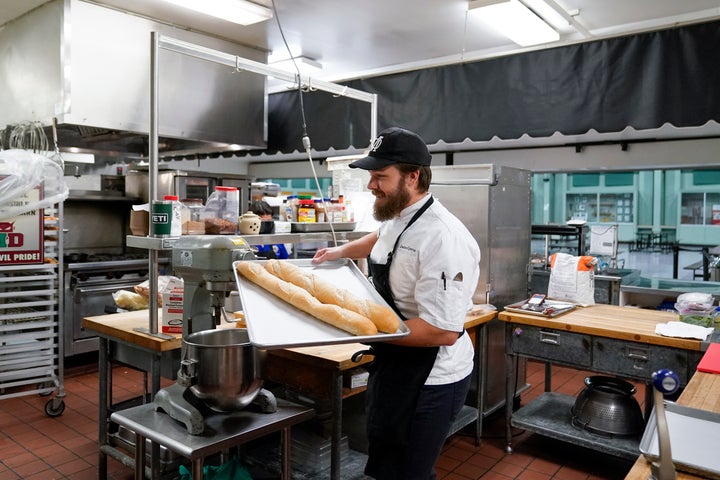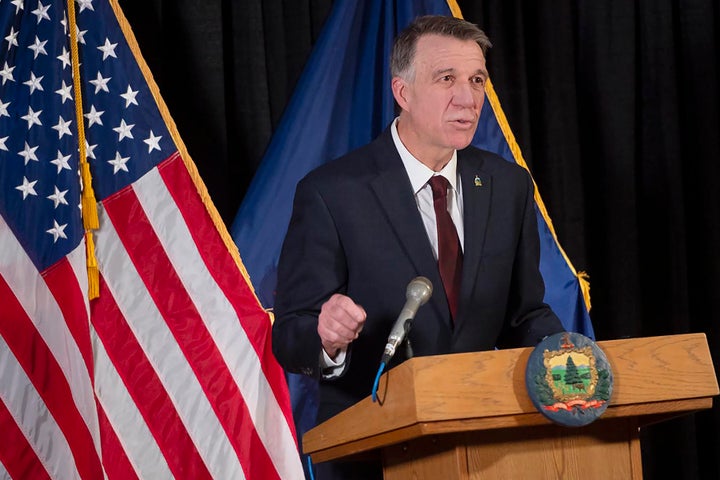How Pandemic Aid Launched A School Lunch Revolution
Before he went to Congress, which was before he became Minnesota’s 41st governor, Tim Walz was a high school social studies teacher and football coach in Mankato, Minnesota, a small city in the state’s south, known as the soybean-crushing capital of the world. One of his tasks was tracking which students paid for their lunches and which ones qualified for free meals.
“Even when I started teaching, kids knew who had the other colored lunch ticket. And all of a sudden, you’ve created this situation of who didn’t have it, and we’ve created tensions of inequities in our very place where kids who need that lunch are,” he told a group of reporters Thursday.
“I used to take the numbers and type them in as a teacher — we all got assigned this duty — and then make lists of who didn’t pay and who the numbers were or whatever,” he continued. “That’s not there any more.”
Starting July 1, Minnesota will offer school children free lunches, regardless of whether they qualify under federal income guidelines or not. It’s part of a growing trend, spurred by child hunger during the COVID-19 pandemic and temporary federal aid meant to alleviate it, of six states in the past two years dramatically expanding access to food for students during the school day to make it universal or nearly so.
“Even when I started teaching, kids knew who had the other colored lunch ticket.”
– Gov. Tim Walz (D-Minn.)
The movement is diverse geographically but not politically, with the expansions all happening in states with Democratic legislatures, though in some cases where the governor is a Republican or a libertarian-leaning Democrat. Aside from Minnesota, the other states that have dramatically expanded free school meals are Vermont, Colorado, Maine, California and New Mexico.
And the trend may just be getting started. About 20 states had or still have legislation pending on the issue this year. Even in states that did not take the step toward universal lunch availability for students, some, like ruby red North Dakota, expanded it significantly.
Anti-hunger advocates are optimistic about further progress, too.
“It is good news,” said Crystal FitzSimons, director of school and out-of-school time programs with the Food Research & Action Center.
“I’m optimistic, ultimately. I mean, I’m not a Pollyanna, but I see glimmers of hope here,” said Annette Nielsen, executive director of the Hunter College New York City Food Policy Center.
“I’m optimistic, ultimately. I mean, I’m not a Pollyanna, but I see glimmers of hope here.”
– Annette Nielsen, executive director of the Hunter College New York City Food Policy Center
The sense of momentum among school meal advocates is palpable and a marked change from several years ago, when their focus was on reducing school lunch shaming, which happened when cash-strapped school districts singled out children of families with school lunch debt.
Why has the idea of giving every school kid a free lunch, regardless of income, taken off now? The answer, oddly enough, is the COVID pandemic.
“I think you can’t understand the dramatic national momentum around universal school meals without the pandemic,” said Anore Horton, the executive director of Hunger Free Vermont.
During the pandemic, the federal government loosened restrictions on eligibility and availability of school meals and related summer meals programs to help ease the hit from lockdowns. When schools returned to in-person classes, the waivers relieving them of things like taking applications and verifying families’ financial information remained in place and schools realized how much simpler and easier it was to administer meal programs.

But that came to an end last summer, when the pandemic waivers the Agriculture Department extended were finally allowed to expire. A bipartisan agreement in Congress allowed for some changes in summer meal programs, but schools faced a return to a pre-pandemic system with higher paperwork barriers and less effectiveness.
That prospect snapped some states into action. California passed a law implementing universal school breakfasts and lunches starting in the 2022-2023 school year. Maine approved a similar law right after California. And in November 2022, Colorado voters approved Proposition FF, which created a universal meal program.
Vermont had a one-year stopgap program with a permanent version enacted June 14, after Republican Gov. Phil Scott declined to sign it but also didn’t veto it, allowing it to become law.
“What I will say is the pandemic really was a trial run for healthy school meals for all and it showed that it worked. It showed it was an easier way to operate programs. And it’s doable. And it’s the right thing to do,” said FRAC’s FitzSimons.
“I think you can’t understand the dramatic national momentum around universal school meals without the pandemic.”
– Anore Horton, the executive director of Hunger Free Vermont
The programs typically lean on the Agriculture Department’s Community Eligibility Program and supplement it with state funds.
The CEP allows school districts where at least 40% of students qualify for free or reduced-price meals because their families are on federal food assistance, cash benefit welfare or Medicaid to offer free meals for all without an application process. That saves the schools headaches from paperwork, tracking meals by whether they are free or reduced-price ones, and collecting lunch fees.
The sources of state funds can differ. In Colorado, under the referendum, the program is paid for by ending income tax deductions for households making $300,000 a year or more. In Vermont, the permanent program will be paid for out of the state’s education fund, which is separate from its general fund and has a variety of revenue sources, including property taxes. Gov. Scott warned the program could drive up property taxes in the state.
But advocates say the tab isn’t as big as it may first appear. Hunger Free Vermont’s Horton said that while the estimate for the one-year stopgap program was $29 million, it was expected to actually come in about a million and a half dollars cheaper, and perhaps become more affordable over time.

Scott’s worry about ballooning costs and taxes is not uncommon among his fellow Republicans. The Republican Study Committee, a group of conservatives who are the biggest ideological group in the House GOP conference, proposed getting rid of CEP entirely in its recent budget plan and tightening income levels for who would qualify for the lunch program, to “limit spending in the program to truly needy households.”
Walz, the Minnesota governor, said the only criticism he had heard was that the program would help families who can afford to buy their children lunch, an objection he said Republicans never make about tax cuts.
“I was like, ’That’s the first time in your life you’ve ever said that,’” he said. “So you’re saying wealthy people are going to benefit from this? And that’s why we shouldn’t do it?”
“We’re not asking that question about any other aspect of school funding,” said Horton. “‘Why aren’t we charging wealthier families for their kid to ride the school bus?’ Like, we just don’t say that about anything else except for meals, breakfast and lunch in school.”
“‘Why aren’t we charging wealthier families for their kid to ride the school bus?’ Like, we just don’t say that about anything else except for meals, breakfast and lunch in school.”
– Anore Horton, the executive director of Hunger Free Vermont
The idea appears popular. FRAC said polling showed 63% of voters would support making school meals universally available.
Even in North Dakota, where the push for universal meals failed, state lawmakers approved increasing the income limit for eligibility from 130% of the federal poverty level to 200%. (The effort may have been helped by the blowback from legislators upping their own meal reimbursement levels while in session after initially turning back a school lunch expansion.)
“I can tell you there are few things that I’ve done that have been more universally popular,” Walz said.
Sen. Debbie Stabenow (D-Mich.), chairwoman of the Senate Agriculture Committee that oversees the program, told HuffPost there was little chance for federal action on the issue, given the difficulty she saw last year in negotiating to keep summer meal programs as the school lunch eligibility waivers expired.
“I think the way that we’re going to get this done right now is through the states,” she said.
fbq('init', '1621685564716533'); fbq('track', "PageView");
var _fbPartnerID = null; if (_fbPartnerID !== null) { fbq('init', _fbPartnerID + ''); fbq('track', "PageView"); }
For all the latest Education News Click Here
For the latest news and updates, follow us on Google News.

